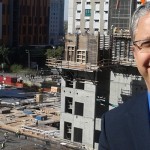Construction is well underway for the Arizona Center for Law and Society, the new home for the Sandra Day O’Connor College of Law in Downtown Phoenix. In anticipation of the move from Tempe, we met with Dean Douglas Sylvester at the Valley Overlook lounge in the Sheraton Phoenix Downtown to talk about what the new campus will mean to students, faculty and the downtown community.
 Located on the fourth floor of the hotel, the Overlook provides an expansive, birds-eye view of downtown and looks directly into the site where the new law school building is rising out of the ground. As we looked over the progress below, we talked with Dean Sylvester about both the opportunities and challenges of relocating to this more urban environment and how this new site signals a new era of increasing public engagement.
Located on the fourth floor of the hotel, the Overlook provides an expansive, birds-eye view of downtown and looks directly into the site where the new law school building is rising out of the ground. As we looked over the progress below, we talked with Dean Sylvester about both the opportunities and challenges of relocating to this more urban environment and how this new site signals a new era of increasing public engagement.
Sylvester joined ASU as an associate professor in 2002 and has watched the university grow and evolve during the last decade of change under Michael Crow’s leadership. He moved to the metro Phoenix area from Chicago, and talked a little about his early first impressions of downtown.
“I remember coming down here on my first week. I was coming from Ahwahtukee, so I gave myself an hour and a half to get here. Of course, I ended up getting here about an hour early,” he said, laughing to himself. “I went, ‘well that’s no problem, I’ll just find a Starbucks.’ But, I couldn’t find a Starbucks, so I literally spent the next hour just walking around this entire area where ASU is now. At that time, it didn’t seem like a place you would seek out, but now…now it’s unbelievable.” With a sweeping gesture, Sylvester points to all of the ASU program buildings that permeate our core, saying “All of this is clearly the biggest change since I’ve been here.”
We asked him to reflect on the key opportunities that having the law school downtown will offer to students and professors. “I think for students and alumni, it’s an unequivocal improvement in a lot of different ways. At the moment Tempe is great and part of a larger research institution, and you have all the things that a great university has to offer. What you don’t have is courts, businesses, and the political center of the state and the city, right down the street. Getting our students as close to employers and getting the law school as close to alumni as we can is going to make a huge difference in the level of connection we have and the level of connections are students can make to everybody else.”
From the faculty’s perspective, it’s a bit more challenging because, as Sylvester points out, there are a lot of people who’ve been in Tempe for a long time. They’ve built relationships on the Tempe campus, and many of them have organized their lives around being in Tempe. Yet, now that the building is going up, he’s already seen a growing interest in the downtown location from previously uncertain faculty.
“I do believe that what will end up happening is that we’ll forge new connections,” he added. “Additionally, we’ll hire new faculty that have never been in Tempe, who’ve only been in downtown, and they will look to different groups and constituencies.”
Dean Sylvester emphasized the opportunities the downtown campus will provide for community engagement. “As a public law school, we have a real commitment to the public and to be engaged in the community wherever we can. I think we already are incredibly engaged, but the idea that a lot of our faculty in their work and in their research are looking more to the public sphere rather than just to fellow academics is not ultimately a bad thing. When you start to adjust your thinking you start to see all the opportunities that downtown will provide.”
In Sylvester’s view, timing has been a significant plus for the law school moving downtown. “One of the things that would have made it a lot more difficult back in 2006 or 2007, was that almost nobody else [from ASU] was down here. I think Public Policy was here, but now the campus itself is so much more alive. And it’s not just an urban downtown feel here, there is a bit of a campus feel, so you have that duality, which is awesome.”
Now is a challenging time for law schools overall throughout the country. Sylvester pointed out that applications to law schools nation-wide are at their lowest level since 1973 and there are almost thirty percent more law schools now. So, on one hand it could seem like an odd time to build such a large facility, when law schools could be perceived as having less relevance than they’ve had in the past. But Sylvester sees it as a tremendous opportunity to rethink law school to make it even more relevant to today’s world.
“We don’t need to educate as many lawyers as before, but what we need to do is educate the very best lawyers. We need to educate them in a way that their value is not just in large firms, representing large institutional clients, but rather in public engagement and service. So, the challenge is really an opportunity to become more relevant.”
And how does Sylvester define “relevance” for the school?
“A relevant law school is basically defined by three concepts. One is it has to be incredibly student-centered. You can’t be purely focused on faculty and research. These are incredibly important things, but if you’re not focused on students of all kinds – not just those who are there to become lawyers but master students, people interested in the history of the law – then you’re not relevant to the very people you’re there to engage. That’s your mission…to educate.”
The second concept that defines relevance for Sylvester is the law school’s ability to “engage this community in issues that matter to them.” He hastens to add, “That doesn’t mean that our phenomenal faculty who think about deep concepts of jurisprudence or legal history are somehow irrelevant, they’re intensely important, but you need to be conscious about how you engage the community.” Sylvester is proud of what ASU already does and believes it will only do more.
“Our students and faculty donate over 100,000 hours a year to free legal services to the Valley,” he said. “It’s about a 10 million dollar economic benefit and once we move downtown, we’ll see those opportunities grow. That will make us relevant.”
The third element to make this new downtown school relevant is the building itself
. It was a foundational question in creating the appropriate design to engage and inform the surrounding community. “So the building is wide open in a lot of ways,” said Sylvester. “Entire walls basically disappear, so that people can come in, enjoy the shade, have a cup of coffee, and while sitting there perhaps watch our video screens and become informed about the news of the day in law, or the history of law, or the importance of law in their lives.” He adds, “I think the real problem that lawyers ran into is that we stopped thinking about how law is such an incredibly positive role in everybody’s life, every day. Law is ultimately structural. It provides the framework 99% of the time for people to move forward in their lives. We make the law relevant by revealing to people how we help, as lawyers , in your life, every single day.”
In line with ASU’s belief in grounding the school in the community has been the creation of the ASU Alumni Law Group, a groundbreaking program modeled on a teaching hospital structure, where you have permanent employees who supervise young associates with real clients. He’s quick to point out that these are not student lawyers. Associates have graduated from law school, have been admitted to the bar, and have to apply to work at the firm for a two to three-year stint. It’s a nonprofit law firm that serves paying clients. The services aren’t free, but they are considerably less than the going rate. This one-of-a-kind program provides legal services to everyday Arizonans in family law, estate planning, criminal defense, civil litigation and small business, which underscores ASU’s commitment to community engagement.
As we looked down at the new school taking shape below, Sylvester noted that construction is on schedule to be completed in May 2016, with move-in scheduled for that summer in time to be open for 2016 fall classes. The underground parking lots are nearly done and next we’ll be seeing the steel framework rising out of the ground. We look forward to seeing how the move to downtown will make ASU’s respected law school even more relevant for the 21st century.







